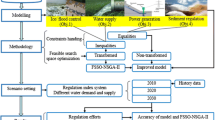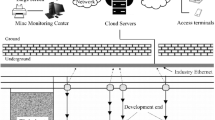Abstract
This exploration aims to propose an urban green rainwater management model based on urban green ecological rainwater system (GERS) to solve the problem of urban waterlogging caused by urbanization and realize the local recycling of urban rainwater resources. First, the urban one-dimensional rainwater pipe network model and two-dimensional surface model are implemented based on MIKE URBAN model. Next, a green ecological rainwater facility model is implemented through node generalization to evaluate the rainwater pipe network pressure and land water area. Finally, the improved multi-objective optimization non-dominated sorting genetic algorithms-II (NSGA-II) is used to optimize the design and research of urban green ecological rainwater simulation systems. The results show that compared with traditional genetic algorithms and non-dominated sorting genetic algorithms (NSGA), the accuracy of NSGA-II is 96.17% and 88.57%, which greatly improves the application performance of the algorithm. The effectiveness of the algorithm is verified by comparing the performance of traditional genetic algorithm (GA) and improved sorting GA. The research conclusion is that NSGA-II is superior to the conventional design scheme in economy and hydraulic performance. The above results can provide a reference for using green ecological rainwater model to solve urban rainstorms and flood management in complex terrain.























Similar content being viewed by others
References
Hu M, Zhang X, Siu YL, Li Y, Tanaka K, Yang H, Xu Y (2018) Flood mitigation by permeable pavements in Chinese sponge city construction. Water 10(2):172. https://doi.org/10.3390/w10020172
Bell CD, McMillan SK, Clinton SM, Jefferson AJ (2016) Hydrologic response to stormwater control measures in urban watersheds. J Hydrol 541:1488–1500. https://doi.org/10.1016/j.jhydrol.2016.08.049
Chui TFM, Liu X, Zhan W (2016) Assessing cost-effectiveness of specific lid practice designs in response to large storm events. J Hydrol 533:353–364. https://doi.org/10.1016/j.jhydrol.2015.12.011
Cano OM, Barkdoll BD (2017) Multiobjective, socioeconomic, boundary-emanating, nearest distance algorithm for stormwater low-impact BMP selection and placement. J Water Resour Plan Manag. https://doi.org/10.1061/(asce)wr.1943-5452.0000726
Petit-Boix A, Sevigné-Itoiz E, Rojas-Gutierrez LA, Barbassa AP, Josa A, Rieradevall J, Gabarrell X (2017) Floods and consequential life cycle assessment: integrating flood damage into the environmental assessment of stormwater Best Management Practices. Journal of Clean Prod 162:601–608. https://doi.org/10.1016/j.jclepro.2017.06.047
Wang M, Zhang DQ, Su J, Dong JW, Tan SK (2018) Assessing hydrological effects and performance of low impact development practices based on future scenarios modeling. Journal of Clean Prod 179:12–23. https://doi.org/10.1016/j.jclepro.2018.01.096
Firehock K, Walker RA, Firehock K et al (2015) Strategic green infrastructure planning: a multi-scale approach[M]. Island press/center for resource economics, Washington, DC
Lottering N, Plessis DD, Donaldson R (2015) Coping with drought: the experience of water sensitive urban design (WSUD) in the George Municipality. Water SA 41(1):1–7. https://doi.org/10.4314/wsa.v41i1.1
Perales-Momparler S, Andrés-Doménech I, Hernández-Crespo C et al (2016) The role of monitoring sustainable drainage systems for promoting transition towards regenerative urban built environments: a case study in the Valencian region, Spain. Journal of Clean Prod 163:S113–S124. https://doi.org/10.1016/j.jclepro.2016.05.153
Li H, Ding L, Ren M, Li C, Wang H (2017) Sponge City construction in China: a survey of the challenges and opportunities. Water 9(9):594. https://doi.org/10.3390/w9090594
Mollerup AL, Mikkelsen PS, Thornberg D et al (2015) Regulatory control analysis and design for sewer systems. Environ Model Softw 66:153–166. https://doi.org/10.1016/j.envsoft.2014.12.001
Simona SC, Marco M, Irena S (2016) A long-term hydrological modelling of an extensive green roof by means of SWMM. Ecol Eng 95:876–887. https://doi.org/10.1016/j.ecoleng.2016.07.009
Leandro J, Martins R (2016) A methodology for linking 2D overland flow models with the sewer network model SWMM 5.1 based on dynamic link libraries. Water Sci Technol 73(12):3017–3026. https://doi.org/10.2166/wst.2016.171
Koudelak P, West S (2007) Sewerage network modelling in Latvia, use of InfoWorks CS and storm water management model 5 in Liepaja city. Water & Environ J 22(2):81–87. https://doi.org/10.1111/j.1747-6593.2007.00079.x
Zhou QQ (2014) A review of sustainable urban drainage systems considering the climate change and urbanization impacts. Water 6(4):976–992. https://doi.org/10.3390/w6040976
Teng J, Jakeman AJ, Vaze J et al (2017) Flood inundation modelling: a review of methods, recent advances and uncertainty analysis. Environ Model Softw 90:201–216. https://doi.org/10.1016/j.envsoft.2017.01.006
Hu L, Lu W, Zhang ZK (2016) Application of MIKE11 model in water quality early-warning and protection in Dong Tiaoxi water source. Chinese J Hydrodyn, doi: https://doi.org/10.16076/j.cnki.cjhd.2016.01.005
Morianou GG, Kourgialas NN, Karatzas GP et al (2016) Hydraulic and sediment transport simulation of Koiliaris River using the MIKE 21C model. Procedia Eng 162:463–470. https://doi.org/10.1016/j.proeng.2016.11.089
Zhang SH, Pan BZ (2014) An urban storm-inundation simulation method based on GIS. J Hydrol 517:26–268. https://doi.org/10.1016/j.jhydrol.2014.05.044
Bisht DS, Chandranath C, Kalakoti S et al (2016) Modeling urban floods and drainage using SWMM and MIKE URBAN: a case study. Nat Hazards 84(2):749–776. https://doi.org/10.1007/s11069-016-2455-1
Chen XL, Zhao SD, Zhao DQ, Sheng Z (2015) Introduction of digitalwater simulation system. Chinese China Water Wastewater 31(1):104–108
Jia HF, Yao HR, Tang Y, Yu SL, Field R, Tafuri AN (2015) LID-BMPs planning for urban runoff control and the case study in China. J Environ Manage 149:65–76. https://doi.org/10.1016/j.jenvman.2014.10.003
Chang TJ, Wang CH, Chen AS (2015) A novel approach to model dynamic flow interactions between storm sewer system and overland surface for different land covers in urban areas. J Hydrol 524:662–679. https://doi.org/10.1016/j.jhydrol.2015.03.014
Zölch T, Henze L, Keilholz P, Pauleit S (2017) Regulating urban surface runoff through nature-based solutions – an assessment at the micro-scale. Environ Res 157:135–144. https://doi.org/10.1016/j.envres.2017.05.023
Campisano A, Butler D, Ward S et al (2017) Urban rainwater harvesting systems: research, implementation and future perspectives. Water Res 115:195–209. https://doi.org/10.1016/j.watres.2017.02.056
Bashar MZI, Karim MR, Imteaz MA (2018) Reliability and economic analysis of urban rainwater harvesting: a comparative study within six major cities of Bangladesh. Resour Conserv Recycl 133:146–154. https://doi.org/10.1016/j.resconrec.2018.01.025
Zhang S, Zhang J, Yue T et al (2019) Impacts of climate change on urban rainwater harvesting systems. Sci Total Environ 665:262–274. https://doi.org/10.1016/j.scitotenv.2019.02.135
Qin Z, Yao Y, Zhao J et al (2021) Investigation of migration rule of rainwater for sponge city roads under different rainfall intensities. Environ Geochem Health. https://doi.org/10.13616/j.cnki.gcjsysj.2020.03.030
Ranaee E, Abbasi AA, TabatabaeeYazdi J et al (2021) Feasibility of rainwater harvesting and consumption in a middle eastern semiarid urban area. Water 13(15):2130. https://doi.org/10.3390/w13152130
Abebe Y, Kabir G, Tesfamariam S (2018) Assessing urban areas vulnerability to pluvial flooding using GIS applications and Bayesian belief network model. J Clean Prod 174:1629–1641. https://doi.org/10.1016/j.jclepro.2017.11.066
MOHURD (2014) Technical guide of sponge city construction[Z]. Ministry of housing and urban-rural development of the People's Republic of China, Beijing, (in Chinese).
DHI (2016) (Danish Hydraulic Institute). Mike URBAN User Manual[Z]. Danish Hydraulic Institute, Hørsholm, Denmark
Lee KS, Cho WS, Hwang JW et al (2015) Numerical simulation for reducing the flood damage of green park using MIKE URBAN. Int J Control & Autom 8(1):37–54
Artina S, Bolognesi A, Liserra T et al (2007) Simulation of a storm sewer network in industrial area: Comparison between models calibrated through experimental data. Environ Model Softw 22(8):1221–1228
Mark O, Weesakul S, Apirumanekul C et al (2004) Potential and limitations of 1D modelling of urban flooding. J Hydrol 299(3–4):284–299. https://doi.org/10.1016/j.jhydrol.2004.08.014
Duchesne S, Mailhot A, Dequidt E et al (2001) Mathematical modeling of sewers under surcharge for real time control of combined sewer overflows. Urban Water 3(4):241–252. https://doi.org/10.1016/S1462-0758(01)00037-1
León AS, Ghidaoui MS, Schmidt AR et al (2006) Godunov-type solutions for transient flows in sewers. J Hydraul Eng 132(8):800–813. https://doi.org/10.1061/(ASCE)0733-9429(2006)132:8(800)
Ahmed ESMS, Mays LW (2013) Model for determining real-time optimal dam releases during flooding conditions. Nat Hazards 65:1849–1861. https://doi.org/10.1007/s11069-012-0444-6
Schmitt TG, Thomas M, Ettrich N (2004) Analysis and modeling of flooding in urban drainage systems. J Hydrol 299(3–4):300–311. https://doi.org/10.1016/j.jhydrol.2004.08.012
Lin S, Hsieh S, Kuo J et al (2006) Integrating legacy components into a software system for storm sewer simulation. Environ Model Softw 21(8):1129–1140. https://doi.org/10.1016/j.envsoft.2005.05.012
Xie JQ, Chen H, Liao ZL, Gu XY, Zhu DJ, Zhang J (2017) An integrated assessment of urban flooding mitigation strategies for robust decision making. Environ Model Softw 95:143–155. https://doi.org/10.1016/j.envsoft.2017.06.027
Boussaïd I, Lepagnot J, Siarry P (2013) A survey on optimization metaheuristics. Inf Sci 237:82–117. https://doi.org/10.1016/j.ins.2013.02.041
Dokeroglu T, Sevinc E, Kucukyilmaz T et al (2019) A survey on new generation metaheuristic algorithms. Comput Ind Eng 137:106040. https://doi.org/10.1016/j.cie.2019.106040
Hussain K, Salleh MNM, Cheng S et al (2019) Metaheuristic research: a comprehensive survey. Artif Intell Rev 52(4):2191–2233. https://doi.org/10.1007/s10462-017-9605-z
Acknowledgements
This work was funded by the Key R & D Project of Shaanxi Province (Project code 2020SF-354) and the Water Conservancy Science and Technology Project of Shaanxi Province (Project code:2015slkj-08). The authors much appreciate the editors and the reviewers for their constructive comments and suggestions which are extremely helpful for improving the paper.
Author information
Authors and Affiliations
Corresponding author
Additional information
Publisher's Note
Springer Nature remains neutral with regard to jurisdictional claims in published maps and institutional affiliations.
Rights and permissions
About this article
Cite this article
Cao, L., Liu, Y. Optimization design and research of simulation system for urban green ecological rainwater by genetic algorithm. J Supercomput 78, 11318–11344 (2022). https://doi.org/10.1007/s11227-021-04192-7
Accepted:
Published:
Issue Date:
DOI: https://doi.org/10.1007/s11227-021-04192-7




